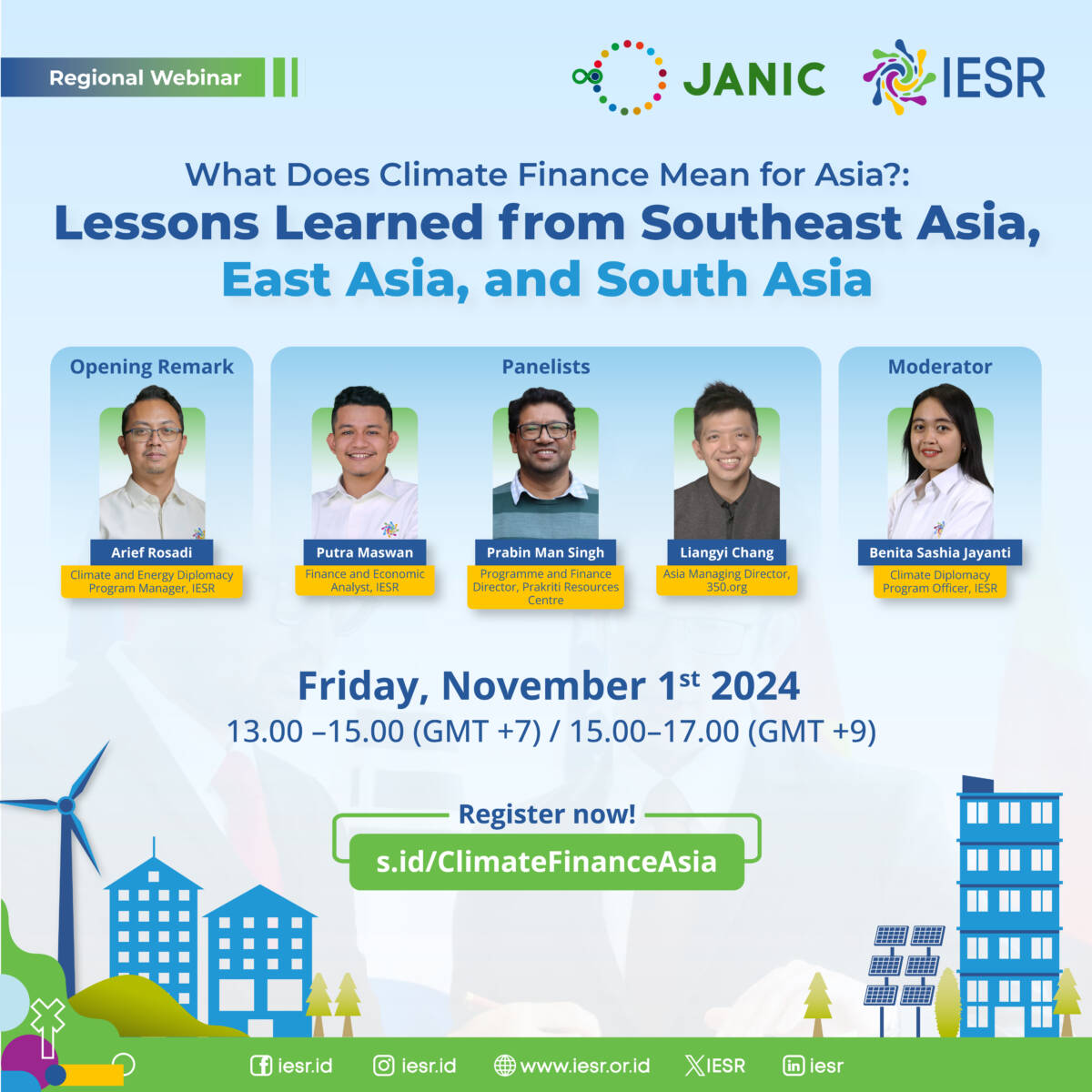
Regional Webinar : What Does Climate Finance Mean for Asia? – Lessons Learned from Southeast Asia, East Asia, and South Asia
Background
Global temperatures are set to surpass the 1.5°C threshold above pre-industrial levels, a limit established to prevent the most catastrophic impacts of climate change. However, global efforts to reduce greenhouse gas emissions (GHGs) fall significantly short. By 2030, emissions are projected to be reduced by only 11%, far below the necessary goal of halving 2019 levels. This shortfall emphasizes the need for intensified global collaboration, particularly from regions like Asia, which is not only home to some of the largest GHG emitters but also one of the most vulnerable areas to climate change (IMF, 2024; WMO, 2024).
As the most disaster-hit region in 2023, Asia and the Pacific region is experiencing accelerated warming, nearly doubling the rate seen between 1961 and 1990. The region bore the brunt of 79 hydro-meteorological disasters in 2023, with floods and storms accounting for over 80% of these events, resulting in more than 2,000 fatalities and affecting nine million people (WMO, 2024). As the climate continues to warm, the intensity of these events is expected to rise. Notably, major emitters like China, India, and Indonesia contribute significantly to the region’s GHG emissions, but the geographical and demographic vulnerability of Asia heightens the stakes for climate adaptation and mitigation efforts ( IMF, 2024).
The Asia and Pacific region, responsible for approximately 50% of global GHG emissions, is at the heart of global climate action (ADB, 2023). Despite significant efforts, the region faces a massive financing gap, with an estimated $1.1 trillion in investment needed annually to address both mitigation and adaptation needs (IMF, 2024). However, only $333 billion of this is being raised, leaving a critical funding gap of $815 billion. This gap is further exacerbated by the depletion of public finances following the COVID-19 pandemic, forcing governments to seek private sector involvement to scale up climate action (IMF, 2024).
According to ADB (2023), in the 2018–2019 period, the region spent at least $519.9 billion, with 30% increasing financing in 2019. Based on the sources of financing, the public sector still contributed most of the overall climate finance (68%) compared to the private sector. This is also the case in most of the sub-regions except South Asia in which private sector finance contributed equally to the public sector. The region’s climate finance efforts in mitigation sectors, particularly in energy, have been robust, with investments in renewable energy, such as solar and wind power, dominating climate mitigation finance. In proportion, the mitigation finance reached up to $472.5 billion (91%) in the same period. On the other hand, adaptation finance, remains vastly underfunded, accounting for only 8% of total climate finance despite its urgency on protecting vulnerable communities (ADB, 2023).
Compared to other sub-regions, East Asia remains the largest recipient of climate finance in the region. It received around 80% of total climate finance, and placed the greater part in mitigation projects in the energy, transport, and building and infrastructure sectors. China’s commitment on achieving its dual-carbon goals were also the main driver for the recent progress. The second and third highest recipients for climate finance are South Asia (9% of total flows) and Southeast Asia (5%), respectively. Climate finance flows mainly in support of clean energy, railway systems, and integrated urban public transportation within these two sub-regions (ADB, 2023).
The dynamics at the regional and country levels within the Asia-Pacific region play a crucial role in the recent progress in climate finance. From the perspective of civil society, cross-regional knowledge sharing on this issue is vital, as similar conditions or strategies may offer valuable lessons for other regions or countries. Moreover, such knowledge exchange would help enhance civil society’s understanding ahead of the upcoming Conference of Parties (COP) 29 in Baku, Azerbaijan, where climate finance will be a key topic of discussion. To support this, the Institute for Essential Services Reform, in collaboration with the Climate Emergency Collaboration Group (CECG), has organized a cross-regional webinar bringing together civil society representatives from East Asia, Southeast Asia, and South Asia.
Objectives
- To discuss recent updates of climate finance in three different Asian regions (South East Asia, East Asia, and South Asia).
- To identify challenges and barriers of climate finance implementation.
- To find a common perspective and solutions on tackling such challenges.
Presentation
Putra Maswan – IESR _ CLIMATE FINANCE IN SOUTHEAST ASIA
Putra-Maswan-IESR-_-CLIMATE-FINANCE-IN-SOUTHEAST-ASIAPrabin Man Singh – Climate Action Network South Asia _ State of Climate Finance in South Asia
Prabin-Man-Singh-Climate-Action-Network-South-Asia-_-State-of-Climate-Finance-in-South-AsiaSpeakers
-
Arief Rosadi - Climate and Energy Diplomacy Program Manager IESR
-
Putra Maswan - Finance and Economic Analyst IESR
-
Prabin Man Singh - Director (Programme and Finance) - Prakriti Resources Centre
-
Liangyi Chang - Sustainable Development Expert
-
Benita Sashia Jayanti - Climate Diplomacy Program Officer IESR

